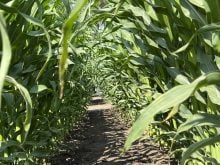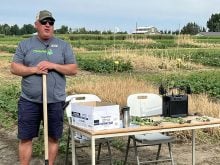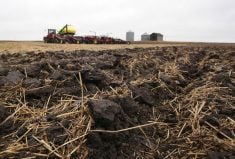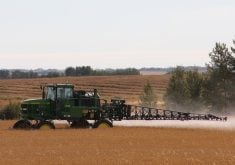Cover crops can help improve soil health, reduce soil erosion, cut fertilizer costs and increase soil organic matter. But how climate change will affect the practice remains a wild card.
A recent study from the University of Illinois suggests cover crops may become less efficient in the future. The study also showed that yields of important crops such as corn and soybeans may suffer under a changing climate influence.
Rabin Bhattarai, associate professor in the university’s Department of Agricultural and Biological Engineering, said there are questions about the long-term implications and effectiveness of cover crops on water quality and crop yield.
Read Also

Saskatchewan puts crown land auction on hold
Auctions of Saskatchewan crown lease land are once again on hold.
“So, we wanted to investigate the long-term impact of winter cover crop adaptation on nutrient loss and crop yield. Understanding future consequences (from climate change) would be of enormous value in trying to plan for and mitigate challenges, and we also wanted to explore how climate change will impact the effectiveness of winter cover crops and crops like corn and soybean.”
In the study, the team used a crop simulation model to forecast growth of rye (the cover crop), corn and soybeans over the near-term (2021-40) and the long-term (2041-60) under two climate scenarios for Illinois. One scenario was the best-case scenario and the other represented business as usual. The cover crop impact scenarios were compared with the baseline scenario of 2001-20.
The team defined the results based on measures known as Representative Concentration Pathways using five regional climate model projections in Illinois of two warming scenarios. One was RCP 4.5 being a medium emission scenario and the other was RCP 8.5 being a high emission scenario.
According to the news release, the researchers looked at the impact of cover crops on cash crop yield. In a previous study, the researchers found growing rye before corn and soybean had a slightly positive effect on yield.
According to Bhattarai, cover crops slowly scavenge soil nitrogen throughout the winter and return the nutrient to the crop, providing a growth boost, when terminated and incorporated into the soil.
“But the corn yield was projected to decrease in all future scenarios,” he said. “For example, the corn yield could be affected by changing climatic conditions ranging from -5.4 percent to 3.8 percent for the near-term future under RCP 4.5 and -11.4 percent to 2.6 percent for the near-term future under the RCP 8.5 scenario. For the far-term future, climate change could affect the corn yield ranging between -10.2 and 5.7 percent in mild (RCP 4.5) emissions and -27.6 to -2.1 percent in high (RCP 8.5) emissions scenarios. The range represents the different regions in Illinois since there is a lot of variability in weather and soil conditions across the state.”
He said farmers may end up using more fertilizer in the future to compensate for the yield loss, especially for corn, which could lead to increases in nutrient loss and greater threats to environmental runoff or other consequences.
They modelled climate impacts on cash crop yield and cover crop biomass. Soybean yield mostly increased across regions and scenarios with yields forecasted up to 27.5 percent higher than present averages. The model predicted cover crop biomass would boom because of climate change with increases between 25 and 103 percent beyond current figures.
“The changing climate could have a positive impact on soybean yield in most of the climate divisions under different scenarios,” he said. “In the near-term future, the changes in the soybean yield could range from 4.9 to 17.8 percent compared to the baseline scenario. In the far-term future, the variability of the changes in soybean yield could increase, ranging from -3.9 to 27.5 percent in both the RCP 4.5 and RCP 8.5 scenarios.”
He said past studies have indicated that soybeans, being a C3 crop, could compensate for increased temperature stress with elevated CO2 concentrations under sufficiently watered and nutrient-rich conditions. C3 plants are those whose first carbon compound produced during photosynthesis contain three carbon atoms.
The climate change impact on cover crop biomass of 25 to 103 percent would be directly related to warmer winters that favour winter cover crop growth and that also provide greater nitrogen availability to the cover crops due to increased microbial activity in warmer soils.
But this could cause over-expansive cover crop growth that could deplete both soil water and nitrogen despite accounting for higher nitrogen reserves predicted during warmer winters.
The news release stated that, at the end of the growing period for cover crops, the amount of biomass could overwhelm the mineralization of the soil, keeping nitrogen locked up and unavailable to cash crops in the spring and summer.
“An increase in soil temperature can accelerate the conversion of soil organic nitrogen to ammonium and then to nitrate in the soil system by microbes,” he said. “This will result in higher cover crop biomass (and) higher nitrate concentration in soil than cover crops can consume. However, elevated temperatures in the future might also create heat stress in cash crops like corn, resulting in a decrease in yield.”
Under the influence of climate change, the team looked at cover crop impact on nitrogen loss. Compared to today’s conditions in which cover crops reduce tile drainage nitrogen by about 30 percent, cover crops might become less effective with as low as 11 percent reduction under the far-term, worst-case-scenario predictions.
“You won’t get the same benefit as you get now,” he said. “You will see better growth of cover crops with the warmer temperatures, but mineralization will overtake their ability to take up nitrogen. There will be more supply than demand. Cover crops will help and be effective at reducing loss. But the efficiency will drop.”
The research was published in the Journal of Environmental Management.








![A top-down approach [to regenerative agriculture] can work, maybe, but it does have limitations. Some food and agriculture companies have realized that this movement should be handed back to farmers, says University of Washington geologist David Montgomery. | File photo](https://static.producer.com/wp-content/uploads/2024/10/22141434/03-RKA121018_david_montgomery2-235x165.jpg)








